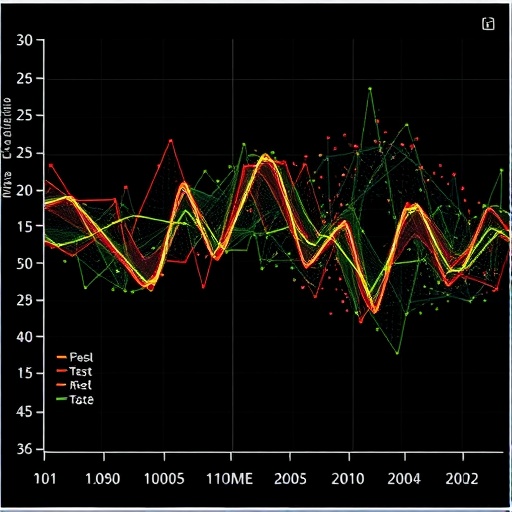In the rapidly evolving field of microbiome research, a pioneering study has unveiled new horizons in understanding the complex ecological networks that govern microbial communities at an unprecedented scale. The work spearheaded by Gibson, Kim, Acharya, and colleagues introduces MDSINE2, a revolutionary computational framework designed to decode ecosystem-level dynamics directly from microbiome data. This advancement transcends traditional analysis, enabling scientists to model and predict the intricate interactions within microbial ecosystems, a breakthrough that promises to reshape how we interpret and manipulate microbial populations across diverse environments.
Microbial ecosystems, ranging from the human gut to oceanic biomes, are astonishingly complex, comprising myriad species with interwoven relationships that change dynamically over time. These interactions dictate not only community composition but also functional outcomes, impacting human health, environmental sustainability, and biotechnological applications. However, capturing the full spectrum of these ecological interactions has remained a daunting challenge due to the sheer complexity and high dimensionality inherent in microbiome data. The introduction of MDSINE2 addresses this bottleneck by leveraging longitudinal data and sophisticated probabilistic modeling to infer dynamical systems that govern microbial assemblages.
At its core, MDSINE2 integrates machine learning algorithms with principles derived from dynamical systems theory, providing a robust framework that goes beyond descriptive statistics. Unlike classical correlation measures that often conflate ecological co-occurrences with causative interactions, this method reconstructs causal relationships by estimating the underlying ordinary differential equations (ODEs) that describe population changes over time. Such an approach affords a mechanistic understanding of microbial dynamics, opening doors to precise manipulation and control of microbiomes.
The methodology incorporates Bayesian inference, allowing MDSINE2 to rigorously quantify uncertainties in estimated parameters and predictions. This probabilistic backbone ensures that the predictions account for inherent noise in biological data, experimental variability, and sampling limitations. Consequently, researchers can evaluate the credibility of inferred interactions and identify which dynamics are confidently supported by the data versus those that require further validation.
More striking is the scalability of MDSINE2, which can process large, complex datasets capturing hundreds of microbial taxa sampled longitudinally across multiple conditions. Traditional ecological modeling approaches often falter under such high dimensionality or require overly simplistic assumptions. MDSINE2 circumvents these obstacles by employing efficient computational algorithms and dimensionality reduction techniques that preserve essential information while enabling tractable inference of ecosystem dynamics.
The team has applied MDSINE2 across diverse microbiome datasets, encompassing human and environmental samples, unveiling nuanced interspecies interactions that had eluded prior analyses. Their results demonstrate that microbial communities are governed not merely by pairwise interactions but also by higher-order effects and context-dependent dynamics, intricately shaped by environmental factors and host physiology. These insights challenge conventional models and highlight the importance of dynamic, ecosystem-scale investigations.
Importantly, MDSINE2’s capability to forecast future states of microbial ecosystems holds tremendous potential in multiple domains. In medicine, such predictive power could revolutionize personalized microbiome therapies, allowing clinicians to anticipate how microbial communities respond to interventions such as probiotics, antibiotics, or diet changes. By simulating perturbations in silico, therapies can be optimized for efficacy and minimal side effects, ushering in a new era of precision microbiome medicine.
In agriculture and environmental management, understanding microbial dynamics can guide sustainable practices that harness beneficial microbes to improve soil health, enhance crop yield, or mitigate pollution. MDSINE2 can assist in designing microbial consortia with desired functions or resilience properties, based on predictive models of interactions under diverse environmental pressures. This prospect aligns with global efforts to employ microbiomes as bioindicators and bioremediation agents.
The study also raises foundational questions about the nature of microbial ecosystems, prompting deeper exploration of emergent properties arising from their dynamic networks. By revealing feedback loops, cooperative behaviors, and competitive exclusion patterns through explicit dynamical equations, MDSINE2 offers a window into ecological principles that bridge microbiology with systems biology and theoretical ecology.
Technically, the framework utilizes gradient matching and Gaussian process priors to efficiently estimate parameters governing the ODEs without requiring prohibitively dense time-series data. This advancement addresses a common limitation in microbiome studies, where temporal sampling is sparse due to logistical or ethical constraints. MDSINE2’s inferential robustness in these data regimes extends its applicability to a wide range of experimental designs and observational studies.
The open-source release of MDSINE2 further democratizes access to cutting-edge microbiome analytical tools, encouraging adoption and adaptation by the research community. Its modular design allows integration with other bioinformatics pipelines and facilitates extensions to incorporate multi-omic datasets such as metatranscriptomics and metabolomics, enriching the ecological context of inference.
Looking ahead, the fusion of MDSINE2 with high-throughput experimental perturbations, such as CRISPR-based gene editing or synthetic community reconstruction, promises to accelerate hypothesis testing in microbiome research. By iterating between predictive modeling and empirical validation, scientists can refine ecosystem models and uncover causal mechanisms underpinning microbiome function with unprecedented precision.
Moreover, the paradigm exemplified by MDSINE2 underscores the transformative impact of interdisciplinary approaches that meld computational innovation with experimental biology. As microbial ecology intersects with artificial intelligence, the prospects for deciphering and designing living ecosystems grow exponentially richer, holding profound implications for health, environment, and industry.
In sum, the development of MDSINE2 heralds a new chapter in microbiome science, empowering researchers to move from static portraits to dynamic narratives of microbial life. By unraveling the complex, time-evolving network of microbial interactions, this tool not only enriches our fundamental understanding but also paves the way for innovative interventions tailored to ecosystem-level outcomes. As the microbial world increasingly reveals its secrets through such computational eyes, the possibilities for science and society become boundless.
Subject of Research: Learning ecosystem-scale dynamics from microbiome data using computational modeling.
Article Title: Learning ecosystem-scale dynamics from microbiome data with MDSINE2.
Article References:
Gibson, T.E., Kim, Y., Acharya, S. et al. Learning ecosystem-scale dynamics from microbiome data with MDSINE2. Nat Microbiol (2025). https://doi.org/10.1038/s41564-025-02112-6
Image Credits: AI Generated
Tags: biotechnological applications of microbiome datacomplex ecological networksdynamical systems theory in microbiome studiesecosystem-level dynamics in microbiomesenvironmental sustainability and microbiomeslongitudinal microbiome data analysismachine learning in microbiome analysisMDSINE2 computational frameworkmicrobial community compositionmicrobiome research advancementsmodeling microbial interactionspredicting microbial ecosystem behavior





